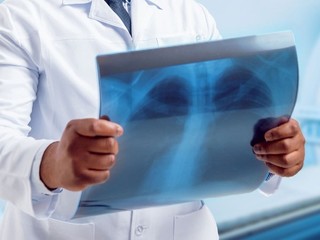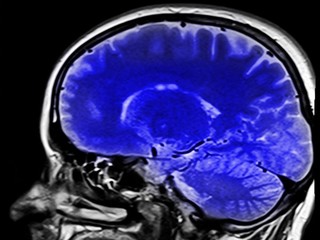DUOS expands AI capabilities to help seniors apply for assistance programs
It will complete and submit forms, and integrate with state benefit systems
Read more...
Much has been written about the lack of testing for COVID-19 across the country, as only a select few, mostly those who already think they're sick, can get them. That leaves the rest of us, who might be asymptomatic, without the ability to find out if we have it. That means we could be spreading it to others without ever knowing, making it that much harder to ever get this virus behind us.
Thankfully, there might be another way to find out who has the disease, one that is not as obvious as sticking a swab up your nose: by studying CT images.
That's the idea from Aidoc, a company that uses deep learning algorithms to analyze medical imaging of the head, chest, spine and abdomen, allowing radiologists to better detect abnormalities. The company's technology is able to flag life-threatening and time sensitive conditions, such as brain hemorrhages or pulmonary embolisms, and then prioritizes those patients so the radiologist knows to look at them first.
Now, the company has received permission from the the FDA to use its AI algorithms to detect findings associated with COVID-19 as well, it was announced on Friday.
To understand how it's going to do that, it's probably best to describe how Aidoc works in life-threatening diseases. The technology is "an AI safety layer that helps triage critical patients," as Elad Walach, co-founder and CEO of Aidoc, describes it.
"Imagine you are an imaging center and have a patient coming in for his elective cancer follow-up. That patient could sometimes wait days for results, so if you have a patient coming in at 5pm on Friday, nobody would even open that exam until Monday morning. What happens if that patient has a critical finding, let’s say pulmonary embolism? Right now, he would go home with a potentially lethal condition," he explained.
Aidoc runs in the background, searching for these critical findings. When it detects something, it then flags and highlights it, making sure that the radiologist finds that patient quickly so they can diagnose them and potentially save their life.
The use case for COVID is similar, Walach explained, though it's not as time sensitive as something that can kill you instantly, like a potential brain hemorrhage. In this case, a patient would come in, get a scan, and Aidoc would look to detect what is known as ground-glass opacity (GGO), a type of finding in the lungs that is associated with COVID, as well as viral pneumonia. Once Aidoc detects this abnormality, it would flag that patient, pushing them to the top of the radiologist's work list, so it can be determined if they have COVID-19 and if they need treatment. That could mean isolating that patient and also disinfecting the scanner that was used so that more patients are not infected.
This type of solution will be especially effective for patients in the second wave of the virus who will not be showing outward signs of having it, Walach explained.
"COVID comes in waves. We now are almost at the end of the first wave, kind of half coming back, not yet but soon we will hopefully come back to semi-normalcy. Then, potentially, a second wave will hit. In that scenario, we’re going to have a lot of asymptomatic patients, so patients who don't know they have COVID," he told me.
"There is more and more evidence about those asymptomatic patients nowadays and it’s definitely going to be more impactful in the second wave as we’re going to be seeing more of those patients."
As Aidoc is trying to detect COVID in patients who don't know they have it, it was important for the company to build a data set of subtle findings, he said, rather than the more obvious signs, as those people would likely already be showing symptoms. So far, the solution has been effective, with Aidoc putting the accuracy rate of detecting COVID through CT scans at around 92 percent, though Walach does expect that to change as the conditions around the virus change as well.
"We believe the numbers will change as the population changes, because you’re going to have more and more of those subtle patients, which now we don’t have," he said.
Founded in 2016, Aidoc, which raised a $27 million Series B round last year, has gone from having one FDA clearance to four over the last 12 months; it now has clearances from the FDA to flag conditions that include intracranial hemorrhage, large-vessel occlusion, PE in pulmonary angiography and cervical spine fractures. The company has not yet received clearance to use its technology to detect COVID-19, but it has received permission.
The company has also grown from being in 100 medical centers globally to 300, and Walach believes that most of them will use its technology for COVID detection.
"We aren’t going to force anybody to join, but I think the vast majority are going to be utilizing this. We’re right now pushing this out to as many, I have a detected team just for this solution. The good thing is that once we’re deployed in a hospital it’s very, very easy to add another module, so it’s not we need a complicated installation, it’s basically the flip of a button," he said.
Ultimately, though, he says that he's just happy to be able to help healthcare workers in any way he can.
"The whole team and I, frankly when this all started we were tearing out our hair trying to find ways to help, because using imaging not obvious. I’m really thankful to our customers that helped us find a way where we can help," Walach said.
"I think we can be a good supportive tool, a good safety net, we will help but it is the doctors, at the end of the day, who are taking the risk and who are on the front lines. We’re fortunate to be able to contribute in some hopefully meaningful way to this effort."
It will complete and submit forms, and integrate with state benefit systems
Read more...The bill would require a report on how these industries use AI to valuate homes and underwrite loans
Read more...The artists wrote an open letter accusing OpenAI of misleading and using them
Read more...
